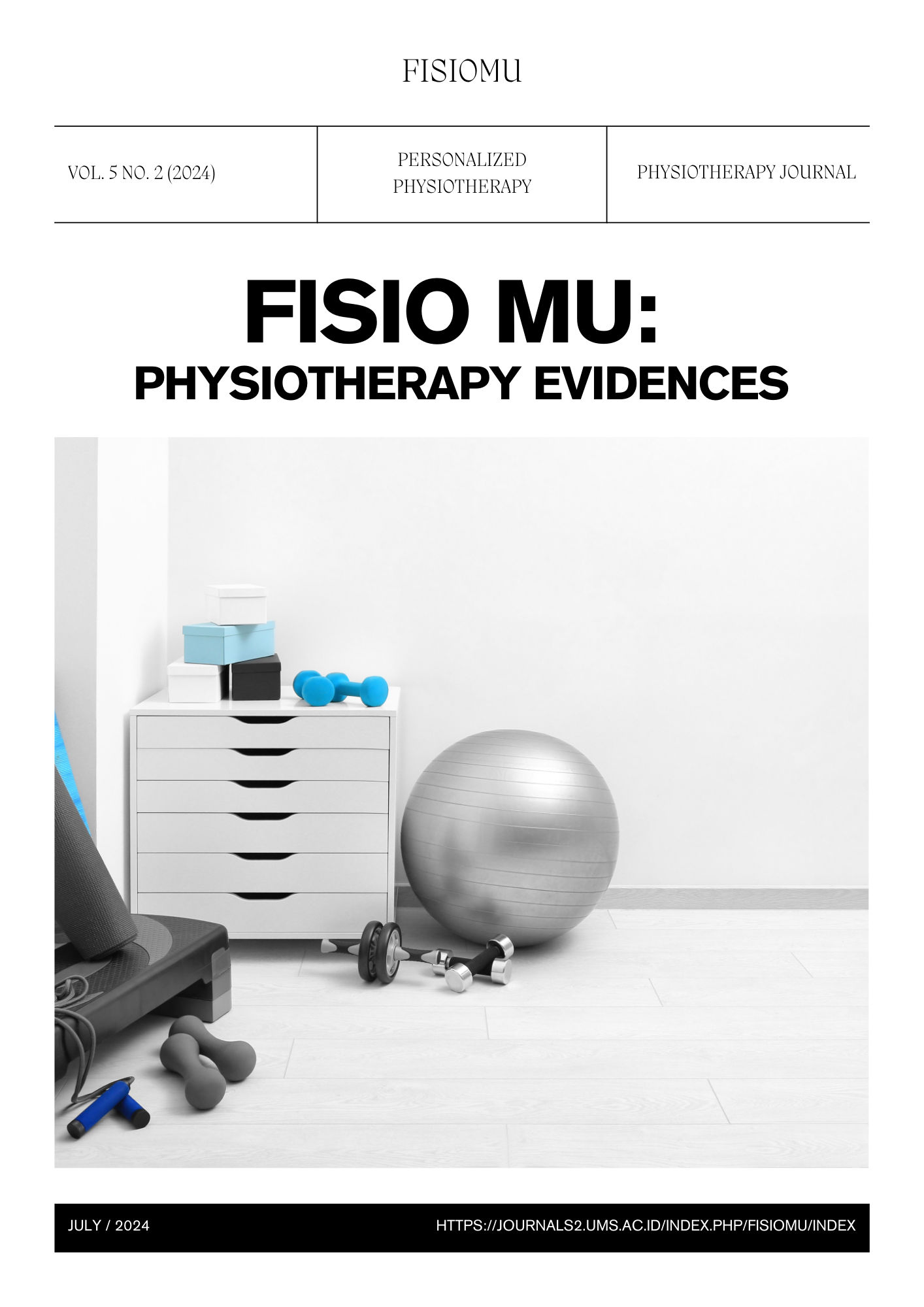Description of Motor Function and Quality of Life in Down Syndrome Children
DOI:
https://doi.org/10.23917/fisiomu.v5i2.4257Keywords:
Down Syndrome, Gross Motor Function, Quality of Life, PhysiotherapyAbstract
Introduction: Down syndrome children occur due to a chromosomal abnormality in the form of an increase in one copy of the 21st chromosome to 3 chromosomes which is called trisomy 21. Down syndrome children experience physical abnormalities in the form of distinctive facial and body shapes as well as delays in motor and mental or cognitive development in the form of intellectual disability. Delays in motor development that occur in children with Down syndrome cause children's movements to be slower and daily activities tend to be done with the help of other people. Children with Down syndrome at school age are given education in special schools so that they receive an educational program that is appropriate to their development. Intellectual disability that occurs causes the educational program provided to be able to train with the aim of children being able to independently carry out their daily activities. Research Objective: to determine the description of motor function and quality of life in children with Down syndrome at the Depok Special Education Foundation. Research Method: a descriptive study with a sample size of 89 people by measuring motor function using GMFM-88 and quality of life using TACQOL. Research Results: motor function of children with Down syndrome in the delayed category with moderate to poor quality of life. Conclusion: children with Down syndrome at YPLB Depok experience delays in motor function compared to their normal age, apart from that their cognitive function has less impact on their quality of life, which is moderate to poor. A training process is needed for independence and developing the talents of children with Down syndrome.
Downloads
References
Abd-Elsamea ES, Abd El-Maksoud GM, Refeat SM. 2022. Correlation between Gross Motor Proficiency and Body Composition in Children with Down Syndrome. Egypt J Hosp Med. 89(1):4235–4239. https://doi.org/10.21608/ejhm.2022.256328
David NS, Mailani R, Faradillah KR, Ismiyasa SW. 2024. The Relationship Between Body Mass Index ( BMI ) and Balance in Down Syndrome Children at the X Depok Foundation. Fisiomu. 4(3):42–47.
Ijezie OA, Healy J, Davies P, Balaguer-Ballester E, Heaslip V. 2023. Quality of life in adults with Down syndrome: A mixed methods systematic review. PLoS One [Internet]. 18(5 May):1–27. https://doi.org/10.1371/journal.pone.0280014
Imania DR, Wahyuningsih IR, Kustiyati S. 2021. Upaya Peningkatan Perkembangan Anak dengan Down Syndrome: Literatur Review. J Ilmu Kesehat. 10(2):42–56.
Jain PD, Nayak A, Karnad SD, Doctor KN. 2022. Gross motor dysfunction and balance impairments in children and adolescents with Down syndrome: a systematic review. Clin Exp Pediatr. 65(3):142–149. https://doi.org/10.3345/cep.2021.00479
Kim HI, Kim SW, Kim J, Jeon HR, Jung DW. 2017. Motor and cognitive developmental profiles in children with down syndrome. Ann Rehabil Med. 41(1):97–103. https://doi.org/10.5535/arm.2017.41.1.97
Lauteslager PEM, Volman MCJM, Lauteslager T, Van den Heuvel ME, Jongerling J, Klugkist IG. 2020. Basic Motor Skills of Children With Down Syndrome: Creating a Motor Growth Curve. Pediatr Phys Ther. 32(4):375–380. https://doi.org/10.1097/PEP.0000000000000743
Lee A, Knafl K, Van Riper M. 2021. Family variables and quality of life in children with down syndrome: A scoping review. Int J Environ Res Public Health. 18(2):1–30. https://doi.org/10.3390/ijerph18020419
Maclennan S. 2020. Down ’ s syndrome. InnovAiT. 13(1):47–52. https://doi.org/10.1177/1755738019886612
Ndeot F, Sum TA, Ndinduk FD. 2022. Analisis Pertumbuhan dan Perkembangan Anak Usia Dini. J Lonto Leok. 4(2):1–12.
Oche Axena Yulhan. 2021. Kualitas Hidup Anak dengan Down Syndrome. Pesqui Vet Bras. 26(2):173–180.
Purnamadyawati P, Bachtiar F, Mailani R. 2022. Penilaian Kualitas Hidup Pasien Gagal Ginjal Kronik dengan Hemodialisis Menggunakan WHOQOL-BREF di RS Setia Mitra Jakarta. J Kesehat Glob [Internet]. 5(3):113–120. http://ejournal.helvetia.ac.id/index.php/jkg/article/view/5148
Ruiz-González L, Lucena-Antón D, Salazar A, Martín-Valero R, Moral-Munoz JA. 2019. Physical therapy in Down syndrome: systematic review and meta-analysis. J Intellect Disabil Res. 63(8):1041–1067. https://doi.org/10.1111/jir.12606
Silva YS, Silva LLG Da, Silva WC Da, Neto AGN, Pereira TDS, Araújo AKC, Tavares AJG, Weber RA, Oliveira LG De, Cunha NE, et al. 2021. Physiotherapy in Down Syndrome: A Literature Review. Int Neuropsychiatr Dis J. 15(4):20–27. https://doi.org/10.9734/indj/2021/v15i430160
Varshney K, Iriowen R, Morrell K, Pillay P, Fossi A, Stephens MM. 2022. Disparities and outcomes of patients living with Down Syndrome undergoing healthcare transitions from pediatric to adult care: A scoping review. Am J Med Genet Part A. 188(8):2293–2302. https://doi.org/10.1002/ajmg.a.62854
Windsperger K, Hoehl S. 2021. Development of Down Syndrome Research Over the Last Decades–What Healthcare and Education Professionals Need to Know. Front Psychiatry. 12(December):1–7. https://doi.org/10.3389/fpsyt.2021.749046
Downloads
Submitted
Accepted
Published
How to Cite
Issue
Section
License
Copyright (c) 2024 Fisio Mu : Physiotherapy Evidaces Journal

This work is licensed under a Creative Commons Attribution-NonCommercial-NoDerivatives 4.0 International License.

This work is licensed under a Creative Commons Attribution-NonCommercial 4.0 International License.
Authors who publish with FISIO MU: Phsiotherapy Evidences agree to the following terms:
- Author(s) retain copyright and grant the journal right of first publication with the work simultaneously licensed under a Creative Commons Attribution-NonCommercial 4.0 International License that allow others to share the work within an acknowledgement of the work’s authorship and initial publication of this journal.
- Author(s) are able to enter into separate, additional contractual arrangement for the non-exclusive distribution of the the journal’s published version of the work (e.g. acknowledgement of its initial publication in this journal).
- Author(s) are permitted and encouraged to post their work online (e.g. in institutional repositories or on their websites) prior to and during the submission process, as it can lead to productive exchanges, as well as earlier and greater citation of published works.









